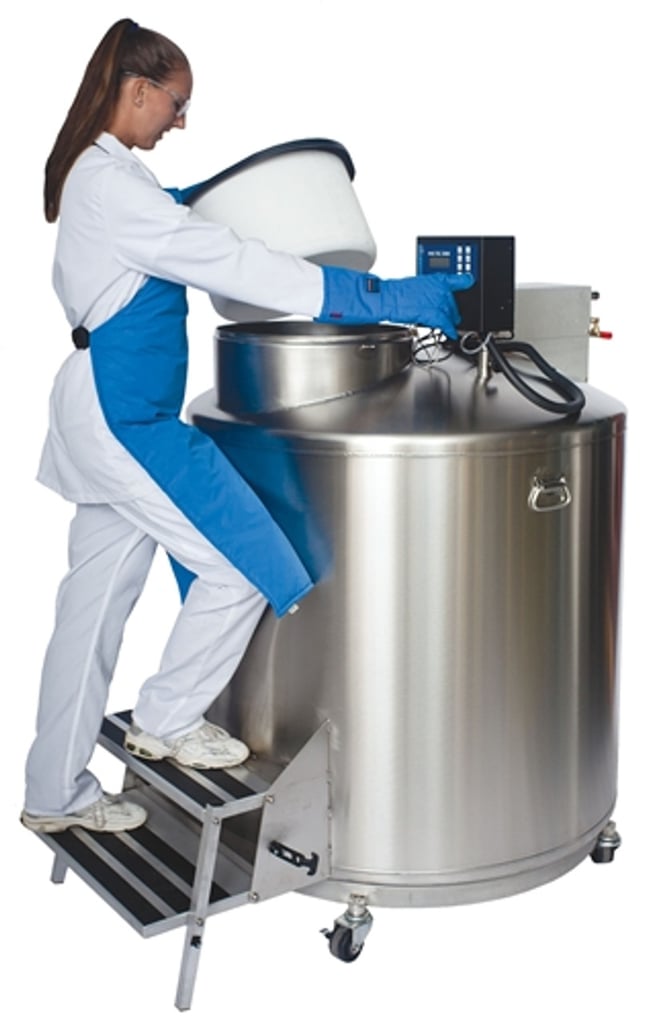The handling of liquid nitrogen requires caution and common-sense knowledge to be safe. Failing to have precautions can lead to personal injury or can lead to the destruction of property. Below are a few tips to consider when handling liquid nitrogen and cryogenically frozen items.
Liquid Nitrogen Can Be Deadly
Liquid Nitrogen produces a large quantity of vapor which is colorless, odorless, and tasteless. These characteristics of vaporized LN2 make it deadly, as inhalation could quickly lead to suffocation. One liter of liquid nitrogen will vaporize into about 25 cubic feet of nitrogen gas. As the nitrogen gas disperses, it quickly reduces the amount of oxygen in the air. Breathing air with less than 18% oxygen will cause dizziness, fainting and eventually death.
The vapor that is released when LN2 is exposed to air is not nitrogen gas, but condensed moisture. Therefore, this liquid should only be used and stored in areas that are fully ventilated. Oxygen monitors are highly recommended wherever liquid nitrogen is being stored or used. This includes using oxygen monitors with liquid nitrogen freezers or dewars. Transporting containers of LN2 is not recommended to be done in trucks without ventilation. Using a truck to transport LN2 must have adequate ventilation and the containers must be secured & supported to prevent spillage.
In the event of someone fainting or feeling dizzy while handling liquid nitrogen, move them promptly to a well-ventilated area and call for emergency assistance (9-1-1). If the person has difficulty breathing, provide oxygen if possible and keep them warm and calm until a medical professional arrives. In case the skin comes into contact with liquid nitrogen or its gas, rapidly return the affected area to the normal body temperature (98.6°F) by removing any tight clothing or equipment and immersing the area in water at 108°F. In case of any medical emergency dialing emergency services (9-1-1) immediately is always recommended.
Handle Liquid Nitrogen with Extreme Care
Liquid Nitrogen is extremely cold and boils at -196°C (320 degrees below zero in Fahrenheit). Contact with human skin can cause serious frostbite, freezing it almost instantly. Wearing protective clothing such as cryogenic gloves, aprons, long pants and boots can help prevent liquid nitrogen & frozen items from touching your skin. Items that were stored in the LN2 liquid can also be harmful and attach to bare skin if contact is made. Objects cooled by the LN2 liquid will stick to exposed skin and will tear flesh away if you try to remove them, use as much caution as possible. Using forceps and tong to remove straws & other times in the storage container while wearing the suggested gloves will help prevent injury.
Safety Equipment to use with Liquid Nitrogen Handling:
- Skin protection:
- Eye protection:
- Face shield over safety glasses
- Chemical splash goggles
Liquid Nitrogen Safe Handling Practices:
- Use only approved containers for storing liquid nitrogen, such as impact-resistant containers that can withstand low temperatures.
- Avoid touching non-insulated vessels containing cryogenic liquids, as they can cause severe injury to your skin.
- Handle liquid nitrogen slowly to minimize boiling and splashing and use tongs to withdraw objects from it.
- Never store liquid nitrogen in a confined or poorly ventilated space.
- Do not transport liquid nitrogen in glass dewars without safety tape or that have wide mouths.
- Store liquid nitrogen in containers with loose-fitting lids only, as a tightly sealed container may build up pressure and explode.
- Do not fill cylinders and dewars to more than 80% of their capacity, as the expansion of gases during warming may cause excessive pressure buildup.
- Avoid tampering or modifying safety devices, such as the cylinder valve or regulator of the tank.
- Do not store liquid nitrogen for extended periods in an uncovered container.
- Be aware that boiling and splashing may occur when charging or filling a warm container with cryogenic liquid, or when inserting objects into the liquid.
- Remember that materials such as carbon steel, plastic, and rubber become brittle at low temperatures, and are therefore dangerous to touch.
For more information on cryogenic safety information you can contact the LabRepCo sales team below. Visit our Cryogenic storage products page to learn more about LabRepCo’s full selection of LN2 freezers, dewars, cryo transport, oxygen monitors or Liquid Nitrogen PPE equipment.










